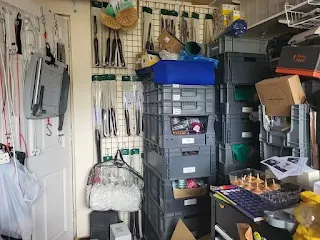Wall Storage on a Budget: My Simple Setup for Organising Tools & Stock
When you're tight on space, every square inch counts - especially if you're running a small business from home. I needed a way to hang tools, other stock and packaging bits in a way that didn’t involve putting up more shelves or stacking more boxes on the floor taking up valuable real estate.
So, I put together a simple wall-mounted grid panel mostly using bits and pieces I already had lying around, a sheet of mesh I bought, plus a few Amazon extras. It didn’t cost much, took less than 2 hours to prep and install, and has made a massive difference to how I use the current space. The entire job cost about €60 and has cured a lot of headaches for me.
Here’s how I did it, and how you can too.
Be sure to check out this great post Game-Changing Amazon Tech and Accessories for Everyday Use after you finish reading here!
What You Need to Do This Job:
- 1 sheet of 2x2 zinc-dipped light steel mesh
- A grinder to cut or ask someone to cut it for you
- A level and a 6-foot straight edge (or a 6-foot level)
- Pencil and measuring tape
- Battery drill (don’t forget a charged battery!)
- 70mm screws and 1–2 inch washers
- Plywood spacers (50mm x 50mm, offcuts work fine)
- Your swearing pants and builder's crack! 😅
Why I Needed a Wall Storage Solution
I used to rely on a bulky 600mm deep x 2m wide x 1.8m high shelving unit that could hold 12 large Euro Containers stacked on the bottom 2 shelves, 3 columns on each shelf, with 12 slim boxes on the top shelf. It seemed efficient at first, but in reality, I was constantly pulling out heavy stock boxes to fulfill orders, often having to move other items out of the way just to reach the one I needed. There was also some dead space I couldn't utilise. Oh, and I couldn't open the door all the way either!What I Used for the New System
I planned to use a zinc dipped 50mm box steel mesh sheet that I would purchase from one of the local Welding/Engineering Fabricators. Make sure it is treated with zinc or stainless steel so it doesn't rust indoors. It happens!Once I figured out the orientation of the sheet, I next needed to figure out if the studs locations were suitable and luckily they were. Studs are generally at 400mm centres if your house was built in the 1990s or later or at 16 inch centres if older. Knock on the wall until the sound is deeper and then use a thin nail and hammer to determine if you can hit the studs. Sometimes the skirting (or trim USA) may give you an indication of a stud if the Carpenter found them when nailing the finished wood.
When you find a stud, measure the distances to find the next few. Once found, use the level and draw a vertical pencil line straight up the wall. This is hopefully the centre of each stud all the way up.
Spacers to Allow Hooks to Work
I cut up some 12mm (1/2'') plywood spacers about 50x50mm or 2x2 inches to allow some distance from the wall for the hooks to work freely. I ran low so some bits were odd sizes but 2x2 is perfect for supporting the fixtures. I used 70mm screws and one inch washers to fix in place. I positioned as many fixings as I could underneath the horizontal steel lines for maximum failsafe support. The corner between the horizontal and vertical line is even better/stronger if it lines up with your stud.
The photo above shows the first round of fixings, I added more afterwards. If you're building something similar, I recommend:
- Hit four studs across, top & bottom
- Add 2 more rows in between, 4 rows total
- Add Extra fixings at irregular points for extra support.
- Make sure that all fixings are no more than 16 inches apart.
- Make sure there are no electrical sockets or switches nearby before you start!!!
What You Can Use It For
- Store tools in SKU order for quick picking
- Instant ability to check stock levels
- Hanging stock items or packaging materials
- Holding light storage bins
- This could work in sheds, offices, or craft rooms as inexpensive displays
I'm an Amazon Affiliate, want to help me out?
Author Note before you read on: If you find this post helpful and you’re planning to buy on Amazon anyway, you can use one of my Amazon UK or Amazon Ireland affiliate links below. These are blue hyperlinks and clearly labelled.
As an Amazon Associate, I may earn a small commission from qualifying purchases at no extra cost to you. It’s a simple way to support my blog/ business and help cover the time I spend researching and writing posts like this.
If you’d prefer not to shop through Amazon but still want to show your support, you can always Buy Me a Coffee below instead. Every bit helps keep the business going.
How the Hooks Worked
Affiliate link – I may earn a small commission if you buy, at no extra cost to you.
Optional Add-Ons
- Plastic bins that clip onto grids (link)
- Hooks for tools, tape, or ribbon rolls (link)
- Clip-on signage or tags if using for craft fairs or markets
DIY Rolling Carts for Chump Change
These are easy roll, non mark heavy duty castors and they are well able to take the weight on top of them. When I need access to the corner, all I do is wheel them out of the way. I have 3 other carts in another area of the house with these new castors on them. I got rid of the old castors I was using when I saw how good this type worked out.
Affiliate link – I may earn a small commission if you buy, at no extra cost to you.
Final Thoughts
This setup has saved me time, space, and a lot of swearing. It’s cheap, tidy, and you can tweak it to suit whatever you’re storing, whether you’re in a shed, spare room, or workshop like me.
If you’re short on space and big on stuff, give this a try.
Thanks for Reading,
David
Maybe You Would Like to Read:
💬 Got thoughts or feedback? Feel free to leave a comment and let me know how you got on!
About the Author
I’m David Condon, a writer and small business owner from Tralee, Co. Kerry. My main work is in handcrafted woodturning and tuition, but this blog gives me space to explore other interests — practical ideas, reviews, and reflections from day-to-day life.
For more details, see the Note from the Author section below.
💬 Note from the Author
This post was written specially for David Condon Finds. If you enjoyed it, you might also like my other projects:
Phoenix DVD Blog – where I write about DVDs, Blu-rays, and life as a collector
David Condon Woodcraft – my main site focused on woodturning and handmade Irish pieces
If you’d like to support my writing, you can do so through the Buy Me a Coffee button below. It helps keep these side projects going — thank you!
Like what you're reading? You can buy me a coffee — sure it’s cheaper than a pint!








Comments
Post a Comment